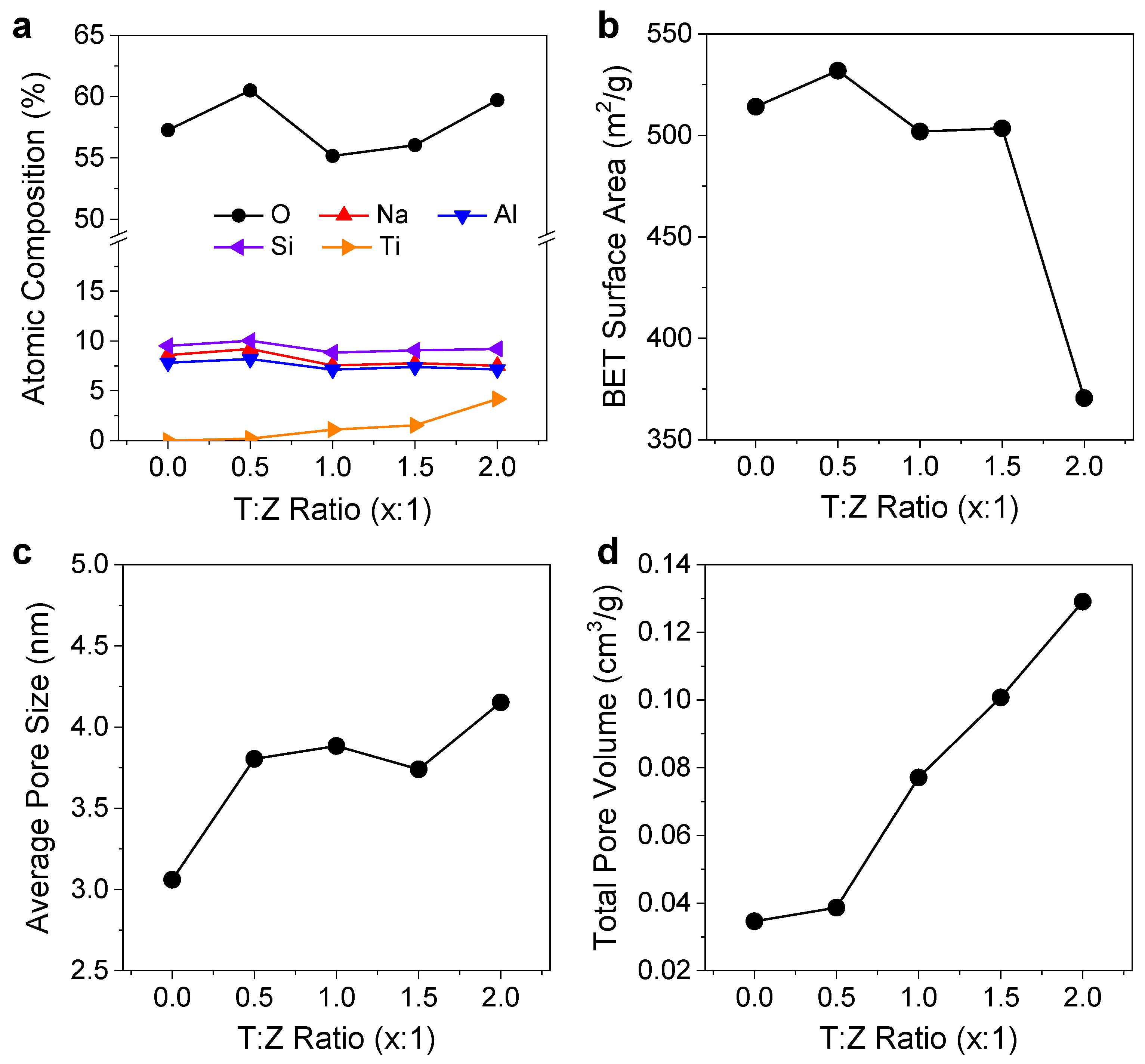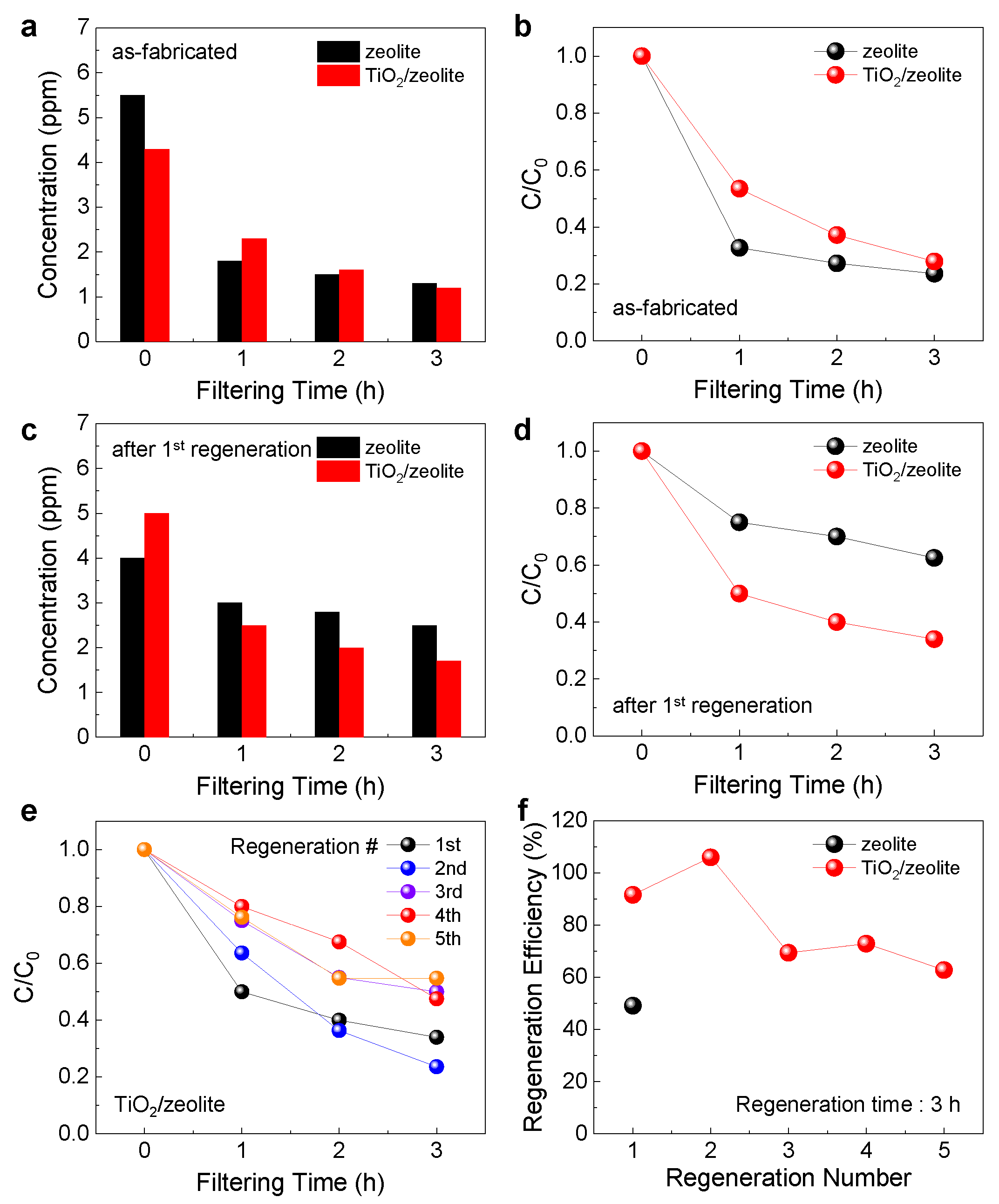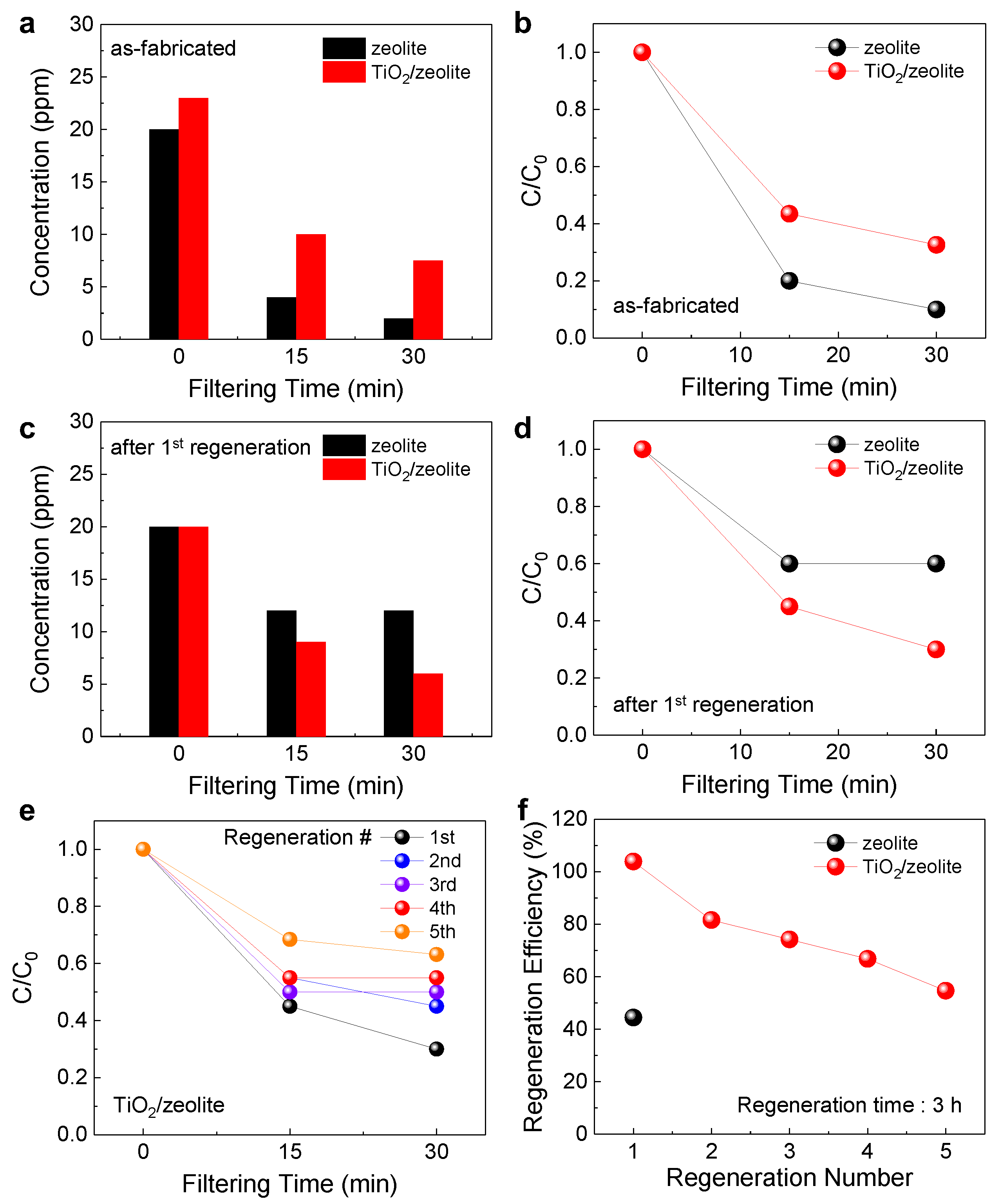Photo-Regeneration of Zeolite-Based Volatile Organic Compound Filters Enabled by TiO2 Photocatalyst
Abstract
:1. Introduction
2. Materials and Methods
3. Results
3.1. Fabrication and Characterization of TiO2/Zeolite Particles
3.2. Fabrication of TiO2/Zeolite-Based VOC Filters
3.3. Adsorption Efficiency and Regeneration Efficiency for Formaldehyde
3.4. Adsorption Efficiency and Regeneration Efficiency for Toluene
4. Conclusions
Author Contributions
Funding
Institutional Review Board Statement
Informed Consent Statement
Data Availability Statement
Conflicts of Interest
References
- Wang, Z.Q.; Zhang, J.S. Characterization and performance evaluation of a full-scale activated carbon-based dynamic botanical air filtration system for improving indoor air quality. Build. Environ. 2011, 46, 758–768. [Google Scholar] [CrossRef]
- Chen, W.H.; Zhang, J.S.S.; Zhang, Z.B. Performance of air cleaners for removing multiple volatile organic compounds in indoor air. ASHRAE Trans. 2005, 111, 1101–1114. [Google Scholar]
- Polidori, A.; Fine, P.M.; White, V.; Kwon, P.S. Pilot study of high-performance air filtration for classroom applications. Indoor Air 2013, 23, 185–195. [Google Scholar] [CrossRef] [PubMed]
- Bai, Y.; Han, C.B.; He, C.; Gu, G.Q.; Nie, J.H.; Shao, J.J.; Xiao, T.X.; Deng, C.R.; Wang, Z.L. Washable Multilayer Triboelectric Air Filter for Efficient Particulate Matter PM2.5 Removal. Adv. Funct. Mater. 2018, 28, 1706680. [Google Scholar] [CrossRef]
- Liu, C.; Hsu, P.-C.; Lee, H.-W.; Ye, M.; Zheng, G.; Liu, N.; Li, W.; Cui, Y. Transparent air filter for high-efficiency PM2.5 capture. Nat. Commun. 2015, 6, 6205. [Google Scholar] [CrossRef] [PubMed]
- Ligotski, R.; Sager, U.; Schneiderwind, U.; Asbach, C.; Schmidt, F. Prediction of VOC adsorption performance for estimation of service life of activated carbon based filter media for indoor air purification. Build. Environ. 2019, 149, 146–156. [Google Scholar] [CrossRef]
- Balanay, J.A.G.; Floyd, E.L.; Lungu, C.T. Breakthrough Curves for Toluene Adsorption on Different Types of Activated Carbon Fibers: Application in Respiratory Protection. Ann. Occup. Hyg. 2015, 59, 481–490. [Google Scholar] [PubMed]
- Sidheswaran, M.A.; Destaillats, H.; Sullivan, D.P.; Cohn, S.; Fisk, W.J. Energy efficient indoor VOC air cleaning with activated carbon fiber (ACF) filters. Build. Environ. 2012, 47, 10. [Google Scholar] [CrossRef]
- Lv, Y.T.; Sun, J.; Yu, G.Q.; Wang, W.L.; Song, Z.L.; Zhao, X.Q.; Mao, Y.P. Hydrophobic design of adsorbent for VOC removal in humid environment and quick regeneration by microwave. Micropor. Mesopor. Mat. 2020, 294, 109869. [Google Scholar] [CrossRef]
- Coss, P.M.; Cha, C.Y. Microwave regeneration of activated carbon used for removal of solvents from vented air. J. Air Waste Manag. 2000, 50, 529–535. [Google Scholar] [CrossRef] [PubMed]
- Liu, C.G.; Zhang, R.; Wei, S.; Wang, J.; Liu, Y.; Li, M.; Liu, R.T. Selective removal of H2S from biogas using a regenerable hybrid TiO2/zeolite composite. Fuel 2015, 157, 183–190. [Google Scholar] [CrossRef]
- Bellat, J.P.; Weber, G.; Bezverkhyy, I.; Lamonier, J.F. Selective adsorption of formaldehyde and water vapors in NaY and NaX zeolites. Micropor. Mesopor. Mat. 2019, 288, 109563. [Google Scholar] [CrossRef]
- Zhang, X.; Tang, D.X.; Zhang, M.; Yang, R.C. Synthesis of NaX zeolite: Influence of crystallization time, temperature and batch molar ratio SiO2/Al2O3 on the particulate properties of zeolite crystals. Powder Technol. 2013, 235, 322–328. [Google Scholar] [CrossRef]
- Ichiura, H.; Kitaoka, T.; Tanaka, H. Removal of indoor pollutants under UV irradiation by a composite TiO2-zeolite sheet prepared using a papermaking technique. Chemosphere 2003, 50, 79–83. [Google Scholar] [CrossRef]
- Takeuchi, M.; Hidaka, M.; Anpo, M. Efficient removal of toluene and benzene in gas phase by the TiO2/Y-zeolite hybrid photocatalyst. J. Hazard. Mater. 2012, 237, 133–139. [Google Scholar] [CrossRef] [PubMed]
- Zhang, G.X.; Song, A.K.; Duan, Y.W.; Zheng, S.L. Enhanced photocatalytic activity of TiO2/zeolite composite for abatement of pollutants. Micropor. Mesopor. Mat. 2018, 255, 61–68. [Google Scholar] [CrossRef]
- Xu, J.; Sun, M.; Mi, Y.M.; Xu, L.F. The formaldehyde adsorption on anatase TiO2 (211) surface. Chem. Phys. Lett. 2021, 778, 138771. [Google Scholar] [CrossRef]
- Kim, K.-J.; Ahn, H.-G. The effect of pore structure of zeolite on the adsorption of VOCs and their desorption properties by microwave heating. Microporous Mesoporous Mater. 2012, 152, 78–83. [Google Scholar] [CrossRef]
- Setvin, M.; Hulva, J.; Wang, H.H.; Simschitz, T.; Schmid, M.; Parkinson, G.S.; Di Valentin, C.; Selloni, A.; Diebold, U. Formaldehyde Adsorption on the Anatase TiO2(101) Surface: Experimental and Theoretical Investigation. J. Phys. Chem. C 2017, 121, 8914–8922. [Google Scholar] [CrossRef]
- Noguchi, T.; Fujishima, A. Photocatalytic degradation of gaseous formaldehyde using TiO2 film. Environ. Sci. Technol. 1998, 32, 3831–3833. [Google Scholar] [CrossRef]






| T:Z Ratio | O | Na | Al | Si | Ti |
|---|---|---|---|---|---|
| 0:1 | 57.27 | 8.59 | 7.82 | 9.52 | 0 |
| 0.5:1 | 60.50 | 9.21 | 8.20 | 10.03 | 0.21 |
| 1:1 | 55.16 | 7.55 | 7.13 | 8.85 | 1.10 |
| 1.5:1 | 56.04 | 7.78 | 7.39 | 9.06 | 1.54 |
| 2:1 | 59.71 | 7.52 | 7.15 | 9.20 | 4.18 |
Publisher’s Note: MDPI stays neutral with regard to jurisdictional claims in published maps and institutional affiliations. |
© 2022 by the authors. Licensee MDPI, Basel, Switzerland. This article is an open access article distributed under the terms and conditions of the Creative Commons Attribution (CC BY) license (https://creativecommons.org/licenses/by/4.0/).
Share and Cite
Kim, T.; Yoo, K.; Kim, M.-G.; Kim, Y.-H. Photo-Regeneration of Zeolite-Based Volatile Organic Compound Filters Enabled by TiO2 Photocatalyst. Nanomaterials 2022, 12, 2959. https://doi.org/10.3390/nano12172959
Kim T, Yoo K, Kim M-G, Kim Y-H. Photo-Regeneration of Zeolite-Based Volatile Organic Compound Filters Enabled by TiO2 Photocatalyst. Nanomaterials. 2022; 12(17):2959. https://doi.org/10.3390/nano12172959
Chicago/Turabian StyleKim, Taegyu, Kunsang Yoo, Myung-Gil Kim, and Yong-Hoon Kim. 2022. "Photo-Regeneration of Zeolite-Based Volatile Organic Compound Filters Enabled by TiO2 Photocatalyst" Nanomaterials 12, no. 17: 2959. https://doi.org/10.3390/nano12172959
APA StyleKim, T., Yoo, K., Kim, M.-G., & Kim, Y.-H. (2022). Photo-Regeneration of Zeolite-Based Volatile Organic Compound Filters Enabled by TiO2 Photocatalyst. Nanomaterials, 12(17), 2959. https://doi.org/10.3390/nano12172959





